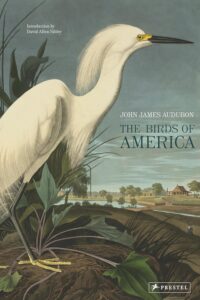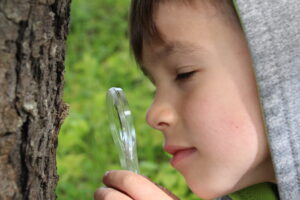Audubon History
A Message from the Board of Directors and Staff
Audubon Community Nature Center (ACNC) is in the process of looking inward. As an organization, we are working to assess where we’ve come from, where we are going, who we are, and who we want to be. We believe this is necessary for us to remain relevant and active within the communities we serve. As an organization built on the three pillars of education, nature, and community, ACNC believes that it is important to tell the full story of John James Audubon, the namesake of the organization. We believe that there is much to learn from the past, but we do not endorse nor do we celebrate all of John James Audubon’s beliefs and actions.
– ACNC Board of Directors and Staff
Who was John James Audubon?

There are 435 hand-colored engravings in Audubon’s seminal work, The Birds of America.

A portrait of John James Audubon by John Syme, 1826.
John James Audubon was born in 1785 in Saint Domingue, now known as Haiti. His father was a French sea captain and sugar plantation owner. His mother died when he was very young and her identity is not known.
Audubon spent most of his childhood in France. At the age of 18, he went to the United States and lived on a family estate near Philadelphia. It was there he was able to pursue his interests in nature, birds, and drawing. He also met Lucy Bakewell, who he later married.
Audubon established a merchant business in Kentucky and Missouri, but his true passion lay in documenting the bird life he encountered. In 1820, he began traveling in earnest, shot gun and art supplies in hand, to collect, study, and paint birds. By shooting birds and posing them with wires, he was able to create more realistic illustrations than his predecessors.
After amassing a large portfolio, he set out to publish his work. He found a market for his art and stories in England. Printed between 1827 and 1838, The Birds of America, features 435 portraits of birds. The Birds of America is still considered to be one of the finest natural history art works.
Audubon’s work brought him fame and influence in society and the natural history field. He continued to travel the United States documenting birds, as well as other animal species until he died in 1851 at the age of 65.
Recent public discussions reveal that there was more to John James Audubon than just these achievements and contributions. While he accomplished an incredible artistic and ornithological feat, he was also accused of plagiarism and fraud. Scholars conclude that Audubon exaggerated, and at times lied, about his wilderness adventures and scientific discoveries. He gave no credit to many of his guides and assistants.
John James Audubon was also a slave owner, purchasing and selling slaves several times. There is documented evidence that he was against the freeing of slaves. Audubon also collected skulls from Mexican and indigenous remains for a colleague, who used them to argue that the white race had bigger and better brains than other races.
What is the National Audubon Society?

Chapters of NAS across the USA.

A photo of Harriet Hemenway.
The National Audubon Society grew from an earlier society, the Massachusetts Audubon Society, formed in 1896, 45 years after the death of John James Audubon, namesake to both societies. Harriet Hemenway and Minna B. Hall of Boston, Massachusetts began gathering groups of women together. Their purpose was to discuss the serious threat posed to birds caused by fashion trends featuring feathers, and sometimes whole birds, on women’s hats. These gatherings lead to the creation of local Audubon chapters whose mission was to protect birds.
The movement took off, and by 1905, the National Association of Audubon Societies (made up of several local chapters) was formed. The association changed its name to the National Audubon Society in 1940.
Similar to any organization with a long history, NAS had many versions of their mission statement over the years. In 2024, at the time of this writing, NAS’ mission statement is: “Audubon protects birds and the places they need, today and tomorrow.”
How Local Audubon Chapters Relate to NAS
Audubon Chapters, such as Audubon Community Nature Center (ACNC), are independently governed organizations, most with their own 501c3 non-profit status. Local chapters do not take direction from nor are they overseen by NAS. Each chapter carries out their own unique mission whose scope may vary from that of NAS.
NAS is made up more than 23 state-level programs, over 450 local chapters, and approximately 41 nature centers/sanctuaries. Audubon New York includes 27 affiliated chapters with 93,000 members. ACNC (one of the 27 chapters within New York State) includes more than 900 membership households.
When an individual joins NAS, they become a member of NAS and are automatically ‘assigned’ a local chapter based on their location. For example, when someone joins NAS and lives in Warren County, Pennsylvania or southwestern New York, ACNC is assigned as their ‘local chapter’. All NAS membership fees go towards supporting NAS’ work at the national level.
An individual can separately join a local chapter, if the chapter has its own membership program. All local chapter membership fees remain within the local chapter and support that chapter’s work.
Abridged Timeline of NAS
The timeline below outlines some of the most significant victories for bird protection and habitat conservation that NAS has been involved throughout their many years of existence.
- 1896 — Massachusetts Audubon Society formed
- 1905 — National Association of Audubon Societies formed
- 1910 — New York State legislature enacted the Audubon Plumage Law, which prohibited the sale or possession of feathers from protected bird species.
- 1918 — The Federal Migratory Bird Treaty Act was ratified, which protected migratory birds from being hunted, sold, and purchased.
- 1923 – 24 — National Association of Audubon opened its first sanctuaries: Rainey Sanctuary in Louisiana and Theodore Roosevelt Sanctuary in Long Island, New York.
- 1940 — The National Association of Audubon Societies became the National Audubon Society (NAS).
- 1998 — NAS held its first Great Backyard Bird Count. Approximately 14,000 people participated.
- 1999 — Almost 50,000 participants took part in the 100th Christmas Bird Count, now the longest-running bird survey in the world.
- 2004 — The NAS science team released the first “State of the Birds” report, the best data available since Silent Spring by Rachel Carson to document bird health and habitat
- 2014 — NAS released Audubon Birds and Climate Change Report.
- 2023 — NAS released a statement about John James Audubon’s racist past. After discussions, NAS announced that they will keep their name. Some local chapters have already elected to remove “Audubon” from their name and others are continuing discussions.
What Is Audubon Community Nature Center?

One way ACNC achieves their mission is through educational programs for children.
Audubon Community Nature Center (ACNC) was founded in 1957 as the Jamestown Audubon Society (JAS). A group of bird and nature enthusiasts gathered around a kitchen table to create an Audubon chapter in Jamestown, New York, the hometown of Roger Tory Peterson.
The first years of the JAS chapter were a flurry of community activity. Volunteers did all of the work, from leading trips and educational presentations, to handling the day-to-day logistics and finances of the small organization.
Since then, the organization has continued to grow. Today, ACNC is a 570-acre wetland preserve that includes over six miles of trails and a three-story nature center. Year-round programming for all ages happens onsite and throughout the community.
ACNC’s mission is to build and nurture connections between people and nature by providing positive outdoor experiences, opportunities to learn about and understand the natural world, and knowledge to act in environmentally responsible ways.
How does Audubon Community Nature Center relate to National Audubon Society?
ACNC is a chapter of NAS, but governed as its own 501c3 non-profit. The mission, vision, beliefs, and budget are neither directed nor overseen by NAS, but rather by a locally-based, volunteer-driven Board of Directors, paid employees, and a team of more than 200 volunteers.
ACNC has a membership program separate from NAS membership that provides members with free admission to the Nature Center as well as other benefits. All of the proceeds from ACNC’s membership, programs, donations, birdseed, and store sales remain local and directly support ACNC.
Abridged Timeline of Audubon Community Nature Center
The abridged timeline below represents significant events from the history of ACNC.
- 1957 — The Jamestown Audubon Society (JAS) was formed as a chapter of National Audubon Society.
- 1963 – 1969 — JAS purchased 189 acres of land at the Riverside Road location where the Nature Center exists today; cleared and created trails, built an observation tower, and the Urban Pavilion.
- 1971 — JAS began teaching nature programs onsite and in Jamestown Public Schools.
- 1975 — JAS hired the first staff member.
- 1976 — The original building was completed and named the “Roger Tory Peterson Nature Interpretive Building.”
- 1978 — JAS held its first summer day camp.
- 1985 — NAS recognized the JAS for having the most extensive education program of any of its 500 chapters.
- 1992 — A major expansion of the Nature Center building was completed.
- 1994 — The paved trail and Blue Heron Overlook were built to increase accessibility to nature.
- 2002 — A large aviary was constructed where Liberty, the Bald Eagle, was put on display.
- 2005 — Conewango Blend birdseed was developed by longtime birders and sold for the first time.
- 2014 —Nature Educators begin to teach in schools throughout Warren County, Pennsylvania in addition to Chautauqua County, New York schools.
- 2016 — The JAS formally changed its name to Audubon Community Nature Center (ACNC)
- 2021 — ACNC welcomed Cricket, the American Kestrel and Soren, the Red-tailed Hawk.
- 2022 — Liberty, the Bald Eagle passed away after spending 20 years at ACNC
Address
Audubon Community Nature Center
1600 Riverside Road
Jamestown, NY 14701
(716) 569-2345
info@auduboncnc.org
Hours and Admission
Nature Center Hours:
Monday - Saturday
10:00 a.m. - 4:30 p.m.
Sunday
1:00 - 4:30 p.m.
Building Admission:
Members - Free
Non-member Adult (ages 16+) - $6
Non-member Child (ages 3 - 15) - $2
Children ages 2 and under - Free
Maximum cost for a Family - $15
Free admission to the Nature Center for SNAP/EBT cardholders.
Free admission for all on Sundays
Grounds and Outdoor Exhibits:
Open daily, year round from dawn to dusk, free of charge
Thank you, Community Partners
Audubon Community Partners make a significant financial contribution each year because they believe that every child deserves the opportunity to have a real and healthy connection to nature.
Bruce and Juline Battler
Carnahan-Jackson Foundation
Chautauqua Region Community Foundation
Donna and Mark Hampton
Holmberg Foundation
Hultquist Foundation
Jessie Smith Darrah Fund
Kinetic Internet Service Provider
The Lenna Foundation
The Ralph C. Sheldon Foundation
David Campbell
Sue and Bill Chandler
Hal and Mary Conarro
Cummins Jamestown Engine Plant
Bob and Kathy Frucella
Kravitz Tree Service
Thomas Kuntz and Meredith Kuntz
Doug and Lamae McCullor
National Fuel Gas Company
Southern Chautauqua
Federal Credit Union
Weinberg Financial Group
Curt and Susie Westrom
Whirley-DrinkWorks!
Jeanne Wiebenga and Jane Stirniman

